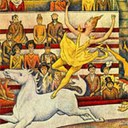0043 The Death of Georges Seurat: Neo-Impressionism and the Fate of the Avant-Garde in 1891
Identifiers (Article)
Identifiers (Files)
Abstract
This essay examines the critical and artistic responses to the death of Georges Seurat in 1891. While some at the time saw the avant-garde divided between scientifically-oriented neo-impressionism and mystical symbolism, the posthumous understanding of Seurat's work increasingly collapsed the two categories. In particular, the neo-impressionist embrace of the aesthetic of Charles Henry, in which compositional lines produced predictable effects on the viewer, made it possible to see Seurat's paintings in purely formal, indeed idealist, terms. The neo-impressionist avant-garde consequently struggled to define its distinctive nature over the course of the year, with important consequences for later art.
Statistics


License

This work is licensed under a Creative Commons Attribution-NonCommercial-NoDerivatives 4.0 International License.



